Infinite-order square tiling
In geometry, the infinite-order square tiling is a regular tiling of the hyperbolic plane. It has Schläfli symbol of {4,∞}. All vertices are ideal, located at "infinity", seen on the boundary of the Poincaré hyperbolic disk projection.
| Infinite-order square tiling | |
|---|---|
 Poincaré disk model of the hyperbolic plane | |
| Type | Hyperbolic regular tiling |
| Vertex configuration | 4∞ |
| Schläfli symbol | {4,∞} |
| Wythoff symbol | ∞ | 4 2 |
| Coxeter diagram | |
| Symmetry group | [∞,4], (*∞42) |
| Dual | Order-4 apeirogonal tiling |
| Properties | Vertex-transitive, edge-transitive, face-transitive |
Uniform colorings
There is a half symmetry form, ![]()
![]()
![]()
![]()
Symmetry
This tiling represents the mirror lines of *∞∞∞∞ symmetry. The dual to this tiling defines the fundamental domains of (*2∞) orbifold symmetry.
Related polyhedra and tiling
This tiling is topologically related as a part of sequence of regular polyhedra and tilings with vertex figure (4n).
| *n42 symmetry mutation of regular tilings: {4,n} | |||||||||||
|---|---|---|---|---|---|---|---|---|---|---|---|
| Spherical | Euclidean | Compact hyperbolic | Paracompact | ||||||||
 {4,3} |
 {4,4} |
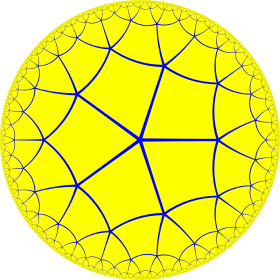 {4,5} |
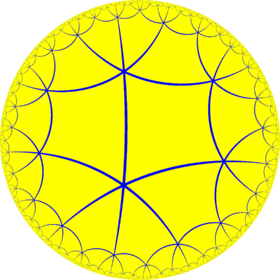 {4,6} |
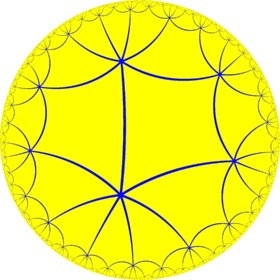 {4,7} |
 {4,8}... |
 {4,∞} | |||||
| Paracompact uniform tilings in [∞,4] family | |||||||
|---|---|---|---|---|---|---|---|
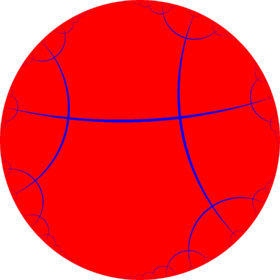 |
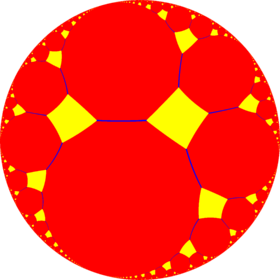 |
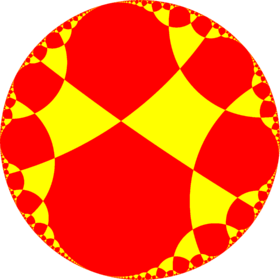 |
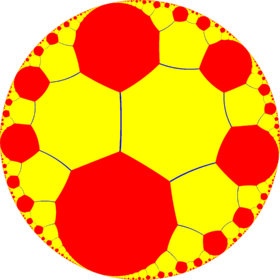 |
 |
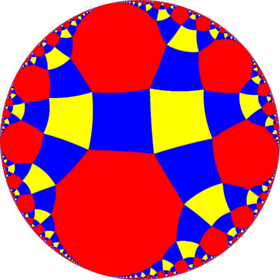 |
 | |
| {∞,4} | t{∞,4} | r{∞,4} | 2t{∞,4}=t{4,∞} | 2r{∞,4}={4,∞} | rr{∞,4} | tr{∞,4} | |
| Dual figures | |||||||
 |
 |
 |
 |
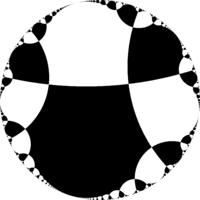 |
 |
 | |
| V∞4 | V4.∞.∞ | V(4.∞)2 | V8.8.∞ | V4∞ | V43.∞ | V4.8.∞ | |
| Alternations | |||||||
| [1+,∞,4] (*44∞) |
[∞+,4] (∞*2) |
[∞,1+,4] (*2∞2∞) |
[∞,4+] (4*∞) |
[∞,4,1+] (*∞∞2) |
[(∞,4,2+)] (2*2∞) |
[∞,4]+ (∞42) | |
= |
= |
||||||
| h{∞,4} | s{∞,4} | hr{∞,4} | s{4,∞} | h{4,∞} | hrr{∞,4} | s{∞,4} | |
 |
 |
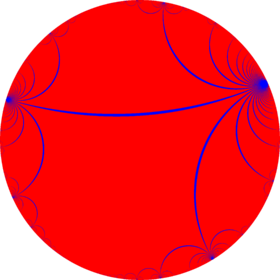 |
 | ||||
| Alternation duals | |||||||
 |
 |
||||||
| V(∞.4)4 | V3.(3.∞)2 | V(4.∞.4)2 | V3.∞.(3.4)2 | V∞∞ | V∞.44 | V3.3.4.3.∞ | |
gollark: `(sys test on)` you.
gollark: Lisp-based commands!
gollark: Better idea: PARSER COMBINATORS!
gollark: PotatOS's code is actually much nicer, on the whole.
gollark: Why did you do it this way? *Deliberate* insanity?
See also
| Wikimedia Commons has media related to Infinite-order square tiling. |
- Square tiling
- Uniform tilings in hyperbolic plane
- List of regular polytopes
References
- John H. Conway; Heidi Burgiel; Chaim Goodman-Strass (2008). "Chapter 19, The Hyperbolic Archimedean Tessellations". The Symmetries of Things. ISBN 978-1-56881-220-5.
- H. S. M. Coxeter (1999). "Chapter 10: Regular honeycombs in hyperbolic space". The Beauty of Geometry: Twelve Essays. Dover Publications. ISBN 0-486-40919-8. LCCN 99035678.
External links
This article is issued from Wikipedia. The text is licensed under Creative Commons - Attribution - Sharealike. Additional terms may apply for the media files.

